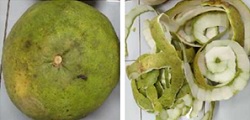GC-MS Analysis of Bioactive Compounds in Ethanol and Ethyl Acetate Fraction of Grapefruit (Citrus maxima L.) Rind
Abstract
The grapefruit (Citrus maxima L.) is a plant known by the public as a fruit consumed with various properties. This plant's use is well known, such as antioxidants, enhancing immunity, anti-aging, and antibacterial properties. This study aimed to identify and analyze the chemical compounds contained in C. maxima rind. The extract was obtained by the maceration method using ethanol and ethyl acetate as solvents. The fractionation process was carried out by Column Chromatography. Observation of thin-layer chromatography profiles with UV lamps 254 and 366 nm. Analysis of chemical compound components using GC-MS and data interpretation based on the Wiley 7.0 data library. The interpretation results of the EF1 fraction were β-copaen-4-α-ol, pentadecanoic acid, hexadecanoic acid, tetradecanoic acid, dotriacontane, osthol, 2H-1-benzopyran-2-one, 7-methoxy-8-(3-methyl-2-oxobutyl), furfural, 6-(2,3-Dihydroxy-3-methylbutyl)-7-methoxycoumarin, and 6-(iodomethyl)-5-methyl-4-oxahexanolide. The chemical compounds identified in EAF2 were 1-octadecanol, decane, tetracosane, hexacosane, and 1,2-benzenedicarboxylic acid (2-ethylhexyl) ester. It can be concluded that these compounds have biological and pharmacological activities.
Full text article
References
2. Khare CP. Indian Medicinal Plants, An Illustrated Dictionary. 1st edition. New York, US: Springer-Verlag New York; 2007.
3. Xu G, Liu D, Chen J, Ye X, Ma Y, Shi J. Juice components and antioxidant capacity of citrus varieties cultivated in China. Food Chem. 2008;106(2):545-51. doi:10.1016/j.foodchem.2007.06.046
4. Arias BÁ, Ramón-Laca L. Pharmacological properties of citrus and their ancient and medieval uses in the Mediterranean region. J Ethnopharmacol. 2005;97(1):89-95. doi:10.1016/j.jep.2004.10.019
5. Ani PN, Abel HC. Nutrient, phytochemical, and antinutrient composition of Citrus maxima fruit juice and peel extract. Food Sci Nutr. 2018;6(3):653-8. doi:10.1002/fsn3.604
6. Marston A. Role of advances in chromatographic techniques in phytochemistry. Phytochemistry. 2007;68(22-24):2786-98. doi:10.1016/j.phytochem.2007.08.004
7. Lal C, Verma LR. Use of certain bio-products for insect-pest control. Indian J Tradit Knowl. 2006;5(1):79-82.
8. Yamunadevi M, Wesely EG, Johnson M. Chromatographic finger print analysis of steroids in Aerva lanata L by HPTLC technique. Asian Pac J Trop Biomed. 2011;1(6):428-33. doi:10.1016/S2221-1691(11)60094-4
9. Saputra KA, Puspawati NM, Suirta IW. Kandungan Kimia Minyak Atsiri dari Kulit Buah Jeruk Bali (Citrus maxima) serta Uji Aktivitas Antibakteri Terhadap Staphylococcus aureus dan Escherichia coli. Jurnal Kimia J Chem. 2017;11(1):58-62. doi:10.24843/JCHEM.2017.v11.i01.p10
10. Khan NH, Qian CJ, Perveen N. Phytochemical screening, antimicrobial and antioxidant activity determination of citrus maxima peel. Pharm Pharmacol Int J. 2018;6(4):279-85. doi:10.15406/ppij.2018.06.00187
11. Zulbayu LOMA. Uji Aktivitas Antiaging dan Antibakteri Ekstrak Etanol dan Etil Asetat Kulit Buah Jeruk Bali (Citrus maxima L.) Secara In Vitro. Yogyakarta, Indonesia: Universitas Gadjah Mada; 2017. Available from: http://etd.repository.ugm.ac.id/penelitian/detail/128679
12. Rahman NFA, Shamsudin R, Ismail A, Shah NNAK. Effects of post-drying methods on pomelo fruit peels. Food Sci Biotechnol. 2016;25(Suppl 1):85-90. doi:10.1007/s10068-016-0102-y
13. Liolios C, Laouer H, Boulaacheb N, Gortzi O, Chinou I. Chemical composition and antimicrobial activity of the essential oil of Algerian Phlomis bovei De Noé subsp. Bovei. Molecules. 2007;12(4):772-81. doi:10.3390/12040772
14. Mujeeb F Bajpai P, Pathak N. Phytochemical evaluation, antimicrobial activity, and determination of bioactive components from leaves of Aegle marmelos. Biomed Res Int. 2014;2014:497606. doi:10.1155/2014/497606
15. Suryowati T, Rimbawan R, Damanik RM, Bintang M, Handharyani E. Identifikasi Komponen Kimia Dan Aktivitas Antioksidan Dalam Tanaman Torbangun (Coleus amboinicus Lour). Jurnal Gizi dan Pangan. 2015;10(3):217-24. doi:10.25182/jgp.2015.10.3.%25p
16. Ibrahim NA, Musa SK, Yassin SM, Abuniama NH, Awadalkareem S, Osama A, et al. Chemical Composition and Antimicrobial Activity of Essential Oil of Belpharis linariifolia. Int J Sci Technol Soc. 2017;5(4):62-6. doi:10.11648/j.ijsts.20170504.12
17. Soosairaj S, Dons T. Bio-active compounds analysis and characterization in Ethanolic plant extracts of Justicia tranquebariensis L. (Acanthaceae) – using GC-MS. Int J Chemtech Res. 2016;9(7):260-5.
18. Shokoohinia Y, Jafari F, Mohammadi Z, Bazvandi L, Hosseinzadeh L, Chow N, et al. Potential Anticancer Properties of Osthol: A Comprehensive Mechanistic Review. Nutrients. 2018;10(1):36. doi:10.3390/nu10010036
19. Chai WM, Liu X, Hu YH, Feng HL, Jia LY, Guo YJ, et al. Antityrosinase and antimicrobial activities of furfuryl alcohol, furfural and furoic acid. Int J Biol Macromol. 2013;57:151-5. doi:10.1016/j.ijbiomac.2013.02.019
20. Sharma RK, Negi DS, Gibbons S, Otsuka H. Chemical and antibacterial constituents of Skimmia anquetelia. Planta Med. 2008;74(2):175-7. doi:10.1055/s-2008-1034281
21. Gnanashree G, Sirajudeen PM. Determination of bioactive compounds in ethanolic extract of Caralluma indica using GC-MS technique. J Pharmacogn Phytochem. 2018;7(6):1675-7.
22. Paudel MR, Chand MB, Pant B, Pant B. Assessment of Antioxidant and Cytotoxic Activities of Extracts of Dendrobium crepidatum. Biomolecules. 2019;9(9):478. doi:10.3390/biom9090478
23. Rukaiyat M, Garba S, Labaran S. Antimicrobial activities of hexacosane isolated from Sanseveria liberica (Gerome and Labroy) plant. Adv Med Plant Res. 2015;3(3):120-5.
Authors
Copyright (c) 2021 La Ode Muhammad Andi Zulbayu, Endang Lukitaningsih, Rumiyati Rumiyati

This work is licensed under a Creative Commons Attribution-ShareAlike 4.0 International License.
This work is licensed under a Creative Commons Attribution-ShareAlike 4.0 International License.
Authors continue to retain the copyright to the article if the article is published in the Borneo Journal of Pharmacy. They will also retain the publishing rights to the article without any restrictions.
Authors who publish in this journal agree to the following terms:
- Any article on the copyright is retained by the author(s).
- The author grants the journal the right of first publication with the work simultaneously licensed under a Creative Commons Attribution License that allows others to share work with an acknowledgment of the work authors and initial publications in this journal.
- Authors can enter into separate, additional contractual arrangements for the non-exclusive distribution of published articles (e.g., post-institutional repository) or publish them in a book, with acknowledgment of their initial publication in this journal.
- Authors are permitted and encouraged to post their work online (e.g., in institutional repositories or on their websites) prior to and during the submission process. This can lead to productive exchanges and earlier and greater citations of published work.
- The article and any associated published material are distributed under the Creative Commons Attribution-ShareAlike 4.0 International License.




